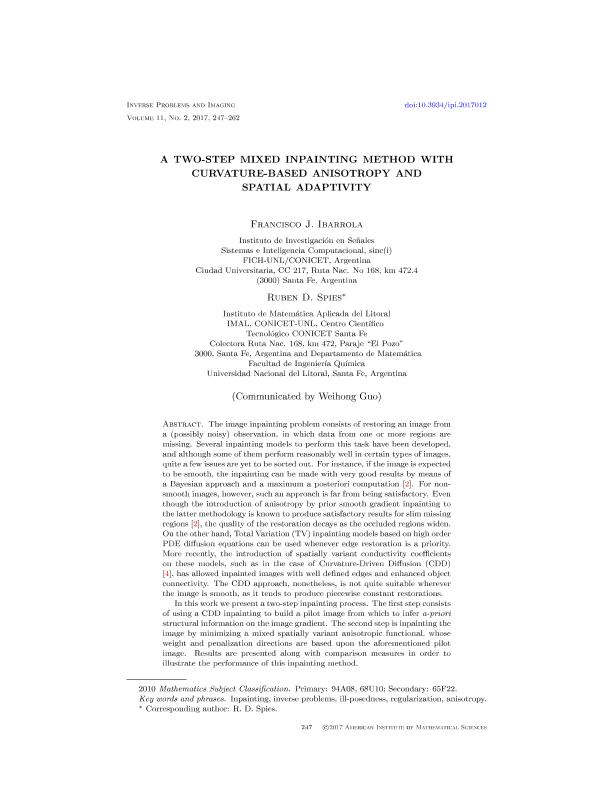Artículo
A two-step mixed inpainting method with curvature-based anisotropy and spatial adaptivity
Fecha de publicación:
04/2017
Editorial:
American Institute of Mathematical Sciences
Revista:
Inverse Problems And Imaging
ISSN:
1930-8337
Idioma:
Inglés
Tipo de recurso:
Artículo publicado
Clasificación temática:
Resumen
The image inpainting problem consists of restoring an image from a (possibly noisy) observation, in which data from one or more regions are missing. Several inpainting models to perform this task have been developed, and although some of them perform reasonably well in certain types of images, quite a few issues are yet to be sorted out. For instance, if the image is expected to be smooth, the inpainting can be made with very good results by means of a Bayesian approach and a maximum a posteriori computation [2]. For non-smooth images, however, such an approach is far from being satisfactory. Even though the introduction of anisotropy by prior smooth gradient inpainting to the latter methodology is known to produce satisfactory results for slim missing regions [2], the quality of the restoration decays as the occluded regions widen. On the other hand, Total Variation (TV) inpainting models based on high order PDE diffusion equations can be used whenever edge restoration is a priority. More recently, the introduction of spatially variant conductivity coefficients on these models, such as in the case of Curvature-Driven Diffusion (CDD) [4], has allowed inpainted images with well defined edges and enhanced object connectivity. The CDD approach, nonetheless, is not quite suitable wherever the image is smooth, as it tends to produce piecewise constant restorations. In this work we present a two-step inpainting process. The first step consists of using a CDD inpainting to build a pilot image from which to infer a-priori structural information on the image gradient. The second step is inpainting the image by minimizing a mixed spatially variant anisotropic functional, whose weight and penalization directions are based upon the aforementioned pilot image. Results are presented along with comparison measures in order to illustrate the performance of this inpainting method.
Palabras clave:
ANISOTROPY
,
ILL-POSEDNESS
,
INPAINTING
,
INVERSE PROBLEMS
,
REGULARIZATION
Archivos asociados
Licencia
Identificadores
Colecciones
Articulos(IMAL)
Articulos de INST.DE MATEMATICA APLICADA "LITORAL"
Articulos de INST.DE MATEMATICA APLICADA "LITORAL"
Citación
Ibarrola, Francisco Javier; Spies, Ruben Daniel; A two-step mixed inpainting method with curvature-based anisotropy and spatial adaptivity; American Institute of Mathematical Sciences; Inverse Problems And Imaging; 11; 2; 4-2017; 247-262
Compartir
Altmétricas




